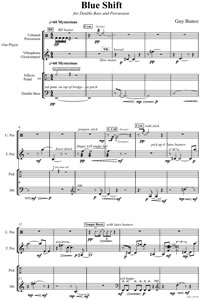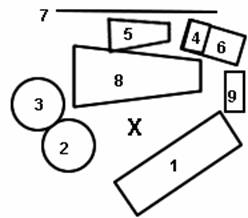Blue Shift (2007)

Blue shift is the phenomenon when the frequency of an electromagnetic wave (such as light) emitted by a source moving towards the observer is shifted towards the blue side of the electromagnetic spectrum (that is, its wavelength is decreased).
This piece represents this phenomenon through its construction. The primary note rows used for the work are based on planatary distances from the sun at a given time converted into hertz. These pitch frequences were then ordered and rotated.
Blue Shift consists of six sections of decreasing length representing the blue shift effect. As the piece progresses, the listerner travels through space towards an unidentified object. As when looking at anything in the distance, the outline of the object (and therefore the music) is initially vague and sketchy. As the journey continues, defenition increases until the object is reached in the final section.
In the piece, the concept of increasing definition is closely associated with a cantus firmus which is presented in the first section (vibraphone moving to double bass) and all subsequent sections. As the sections of the piece get shorter, the cantus notes upon which other music is hung become closer together and more defined. In addition, one comon observation of blue shift is the Doppler effect where pitch increases as a traveling object apporaches the listerner. This was interwoven into the piece as the cantus and tonal centres of each section are a tone higher than the last.
Instrumentation:
Double Bass:
The player should use an acoustic double bass which ideally has 5 strings. Provision is made in the score for basses with the C extension. The bass should have an electric pickup installed which is wired through an effects pedal into an amplifier. It is important that an acoustic bass is used rather than a purely electric one as the natural sound of the instrument should be heard against the amplified effect. The amplifier should be set to a naturalistic sound with a little bit of reverb if possible. The amplified volume should equate that of the natural bass. Ideally, the performer should use a BOSS ME-50B Multiple Effects Pedal. This compact unit contains all the effects required for the piece and is simple to use. If it is not possible to use this particular pedal, other provisions are made in the preface to the score.
This piece represents this phenomenon through its construction. The primary note rows used for the work are based on planatary distances from the sun at a given time converted into hertz. These pitch frequences were then ordered and rotated.
Blue Shift consists of six sections of decreasing length representing the blue shift effect. As the piece progresses, the listerner travels through space towards an unidentified object. As when looking at anything in the distance, the outline of the object (and therefore the music) is initially vague and sketchy. As the journey continues, defenition increases until the object is reached in the final section.
In the piece, the concept of increasing definition is closely associated with a cantus firmus which is presented in the first section (vibraphone moving to double bass) and all subsequent sections. As the sections of the piece get shorter, the cantus notes upon which other music is hung become closer together and more defined. In addition, one comon observation of blue shift is the Doppler effect where pitch increases as a traveling object apporaches the listerner. This was interwoven into the piece as the cantus and tonal centres of each section are a tone higher than the last.
Instrumentation:
Double Bass:
The player should use an acoustic double bass which ideally has 5 strings. Provision is made in the score for basses with the C extension. The bass should have an electric pickup installed which is wired through an effects pedal into an amplifier. It is important that an acoustic bass is used rather than a purely electric one as the natural sound of the instrument should be heard against the amplified effect. The amplifier should be set to a naturalistic sound with a little bit of reverb if possible. The amplified volume should equate that of the natural bass. Ideally, the performer should use a BOSS ME-50B Multiple Effects Pedal. This compact unit contains all the effects required for the piece and is simple to use. If it is not possible to use this particular pedal, other provisions are made in the preface to the score.

Percussion:
1 = Bass Drum
2 = Snare Drum
3 = Cymbal suspended above snare drum
4 = Temple block on stand
5 = Glockenspiel
6 = table for beaters
7 = music stand
8 = Vibraphone
9 = small table to lay 2 violin bows on
Beaters required:
2 violin bows, 1 drum stick (snare drum type), 4 latex beaters, 1 bass drum beater, 2 wood mallets, 4 cord mallets
1 = Bass Drum
2 = Snare Drum
3 = Cymbal suspended above snare drum
4 = Temple block on stand
5 = Glockenspiel
6 = table for beaters
7 = music stand
8 = Vibraphone
9 = small table to lay 2 violin bows on
Beaters required:
2 violin bows, 1 drum stick (snare drum type), 4 latex beaters, 1 bass drum beater, 2 wood mallets, 4 cord mallets


